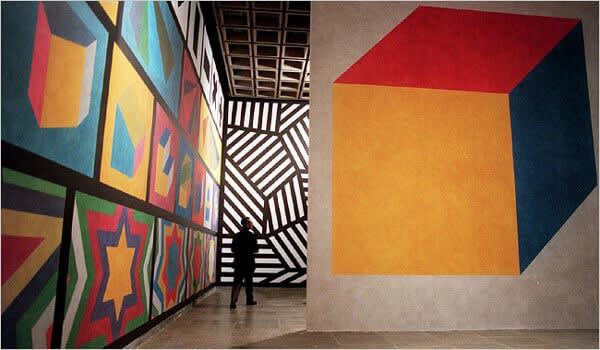Sol Lewitt
-
 Sol LewittCube Without a Corner and Cube Wthout a Cube, 2005Shaped from solid slabs of syntactic Polyurethane and painted in laquer18w x 12d x 7h in.
Sol LewittCube Without a Corner and Cube Wthout a Cube, 2005Shaped from solid slabs of syntactic Polyurethane and painted in laquer18w x 12d x 7h in.
45.72 x 30.48 x 17.78 cmsigned and numbered on the bottom of the base -
 Sol LewittComplex Structure In a Contained Space, 1988Gouache on paper22 1/2 x 29 5/8 ins 57.15 x 75.56 cmSigned S. Lewitt
Sol LewittComplex Structure In a Contained Space, 1988Gouache on paper22 1/2 x 29 5/8 ins 57.15 x 75.56 cmSigned S. Lewitt
Sol LeWitt
Sol LeWitt was an American artist who pioneered Conceptual and Minimalism in the 1960s, a push against post-war Abstract Expressionism.
Early Life and Education
Sol LeWitt was born Solomon LeWitt, in Hartford, Connecticut in 1928. LeWitt was the only child of Jewish immigrant parents from Russia. His father was a doctor, his mother a nurse.
LeWitt’s father died when LeWitt was six, and he was raised by his mother and aunt in New Britain, Connecticut. LeWitt spent much of his free time, as a child, drawing on wrapping paper at his aunt’s grocery store.
His mother encouraged his artistic aspirations and enrolled him at art classes at the Wadsworth Atheneum Museum in Hartford. After receiving a BFA from Syracuse University in 1949, then traveling around Europe, LeWitt was drafted into the army, where designed military posters during the Korean War.
Career
After his stint in the military, LeWitt moved to New York and set up a studio on Hester Street, on the Lower East Side. He worked at Seventeen magazine, doing paste-ups and mechanicals, while studying at the School of Visual Arts then, in 1955, he did graphic design, for a year, at the newly-establish design firm of architect I.M. Pei.
He took a job at the Museum of Modern Art, where he met other young artists and discovered the photographs of Edward Muybridge, which inspired him to reduce his own work to bare essentials. He began to develop his ideas about Conceptual Art.
He wrote Sentences on Conceptual Art in 1969, 35 sentences that explain his ideas philosophy, including, “Ideas can be works of art; they are in a chain of development that may eventually find some form. All ideas need not be made physical.” The original manuscript of Sentences on Conceptual Art is in MoMA’s permanent collection.
LeWitt’s work, both two and three-dimensional, used simple, geometric forms. He often did wall paintings for gallery shows that he knew would be painted over after the exhibit.
LeWitt taught at New York University and the School of Visual Arts during the late 1960s. His works, many put together by teams that he hired, earned him a retrospective at MoMA in 1978.
In 1980, LeWitt moved to Spoleto, Italy and his work became more fluid and colorful.
LeWitt moved back to the States in the late 1980s, and made his home in Chester, Connecticut with his wife and two daughters. He died in 2007 at age 78.
Legacy
Sol LeWitt was known for his generosity and love of collaboration. He often showed his works at small galleries with young artists and would buy their works for his collection. LeWitt helped to found Printed Matter, which published artists’ books. He put much of his art collection on long-term loan at the Wadsworth Atheneum, where he studied as a child.
LeWitt attended Beth Shalom Rodfe Zedek, a synagogue he designed in Chester, Connecticut in collaboration with architect Stephen Lloyd. The works of Sol LeWitt can found in the permanent collections of the Tate Modern, the Centre Georges Pompidou, the Hallen fur Neue Kunst Schaffausen in Switzerland, the Australian National Gallery, the Guggenheim, the Jewish Museum, the National Gallery of Art in Washington, D.C. and other major venues around the world.
-

Remembering Frank Stella (1936-2024)
May 9, 2024Frank Stella died on Saturday, May 4, at the age of 87. He changed the way the world views art, creates art and defines art....Read more -

The Work of Helen Frankenthaler and Sol Lewitt at VFA
February 7, 2024Helen Frankenthaler (1928-2011) became one of the most influential artists of the twentieth century when she expanded the limits of Abstract Expressionism by pouring turpentine-thinned...Read more -

Equitable Building Crash
June 11, 2019Last Monday’s calamitous helicopter crash, into the roof of the 54-story Equitable Building on Seventh Avenue in Manhattan, killed the pilot, left wreckage and caused...Read more -

Sol LeWitt: Cube Without a Corner and Cube Without a Cube at VFA
January 8, 2019If you’re a Sol LeWitt fan, and haven’t had a chance to see the Wall Drawing Retrospective at the Massachusetts Museum of Contemporary Art (Mass MoCA), there’s still plenty of time. Thanks to the Yale University Art Gallery and other donors, the exhibit will be on display until 2043. Sol LeWitt: A Wall Drawing Retrospective, opened to the public on November 16, 2008, a year and a half after LeWitt’s death. Beginning in 2004, LeWitt helped to design and plan the retrospective, which covers about an acre of wall space. On exhibit are 105 drawings by LeWitt, made over a 38 year period.Read more







